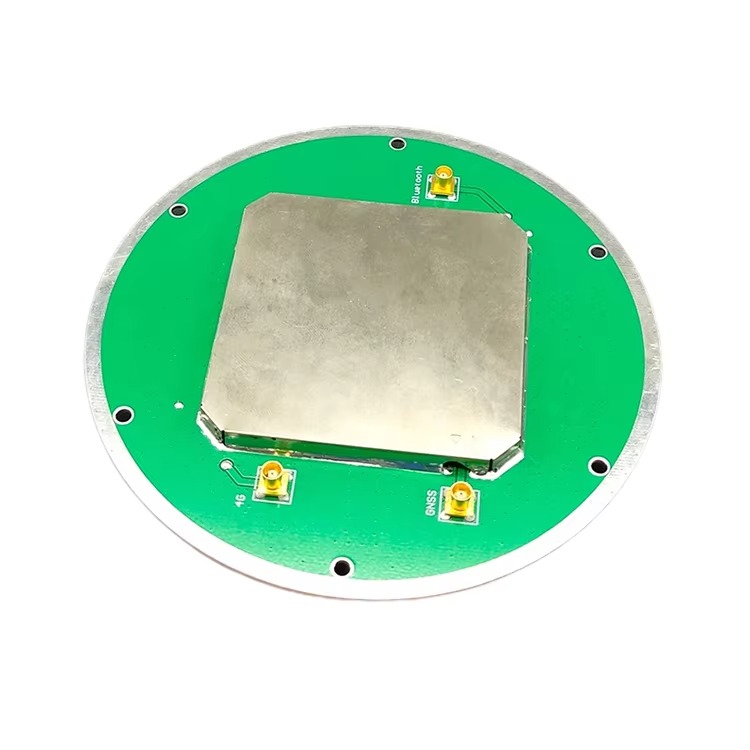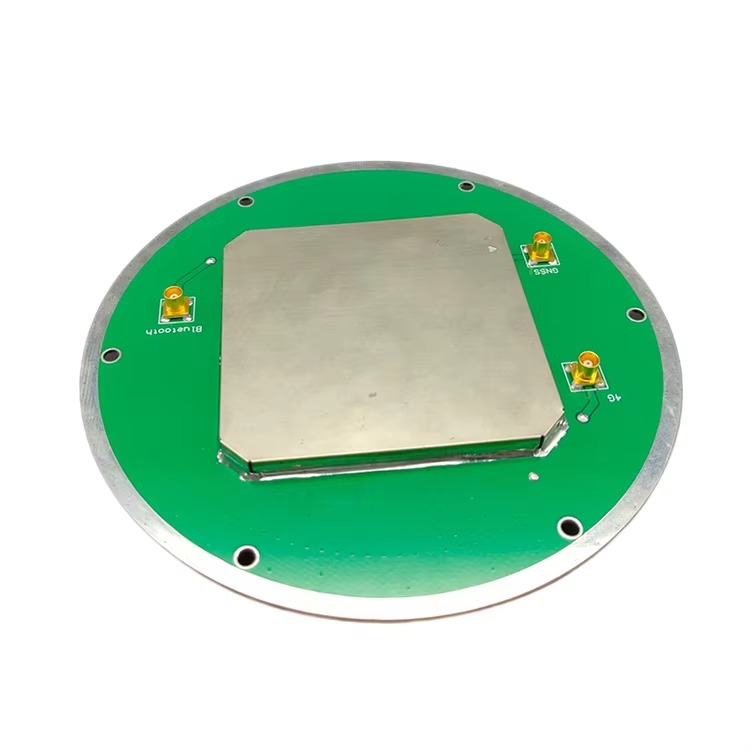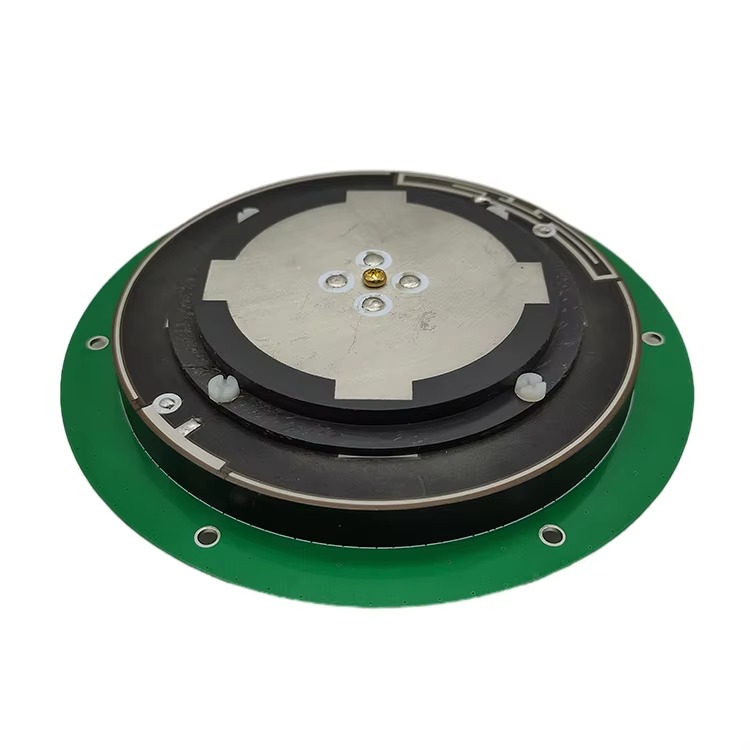CORS Base Station Antenna’s capabilities
At the heart of the CORS Base Station Antenna’s capabilities is its comprehensive frequency range, which spans all major GNSS constellations and bands: GPS L1/L2/L5, GLONASS L1/L2, BDS (BeiDou) B1/B2/B3, and Galileo E1/E2/E5a/E5b. This multi-band coverage is critical for CORS applications, as it allows the antenna to receive signals from multiple satellite systems simultaneously, enhancing redundancy, accuracy, and reliability. Each frequency band serves a specific purpose: L1/E1/B1 bands are the primary civilian bands for GPS, Galileo, and BeiDou, respectively, providing widespread coverage; L2/L5/E5a/E5b/B2/B3 bands offer higher precision and resistance to interference, enabling advanced correction algorithms. For example, GPS L5 and Galileo E5b are designed for safety-critical applications, with wider bandwidths and better signal integrity, making them ideal for CORS networks that require sub-centimeter accuracy. By supporting all these bands, the antenna ensures that the CORS base station can leverage the strengths of each constellation, mitigating the impact of signal blockages, atmospheric interference, or satellite outages. This comprehensive coverage is particularly valuable for global CORS networks, as it allows seamless operation across regions where different GNSS systems may be more prevalent—such as BeiDou in China, GLONASS in Russia, or Galileo in Europe.
The antenna’s output standing wave ratio (VSWR) of ≤2.0 is a key indicator of its efficiency in transferring signal power, a critical factor for maintaining the integrity of weak GNSS signals. VSWR measures the mismatch between the antenna and the connected transmission line (typically a coaxial cable), with lower values indicating more efficient power transfer. A VSWR of ≤2.0 ensures that over 90% of the received signal power is transmitted to the base station’s receiver, minimizing loss and maximizing the signal-to-noise ratio. This is essential for CORS applications, where even minor signal degradation can introduce errors into the reference data, which are then propagated to user equipment across the network. The low VSWR is achieved through careful design of the antenna’s radiating elements and matching network, ensuring that impedance is optimized across all frequency bands. For example, the matching network is tuned to minimize reflections at each GNSS band, ensuring consistent performance whether the antenna is receiving GPS L1 or BeiDou B3 signals. This efficiency is particularly important for weak signals from low-elevation satellites, which are critical for improving the geometric dilution of precision (GDOP) in the positioning solution.
A maximum gain of ≥5.5 dBi for GNSS signals (and ≥-1 dB for GSM900/GSM1800, supporting auxiliary communication) ensures that the antenna can capture and amplify weak satellite signals, even in challenging environments. Gain measures the antenna’s ability to focus signal energy in a specific direction—in this case, toward the sky, where GNSS satellites reside. The ≥5.5 dBi gain for GNSS is optimized for the upper hemisphere, maximizing reception of signals from satellites at various elevations, from near the horizon to directly overhead. This high gain is achieved through a combination of a directional radiation pattern and an integrated low-noise amplifier (LNA), which boosts signal strength without introducing significant noise. For CORS base stations, which are often located in remote areas with limited satellite visibility (such as mountainous regions or dense forests), this gain is critical for maintaining a stable lock on enough satellites to compute accurate position fixes. The GSM900/GSM1800 support, with a gain of ≥-1 dB, enables the antenna to double as a communication link for transmitting CORS data to a central server or user equipment via cellular networks, eliminating the need for a separate communication antenna and simplifying base station design.
The antenna’s working current of ≤40mA and operating voltage range of 3~18VDC highlight its efficiency and flexibility in power management, key considerations for remote CORS base stations often powered by batteries or solar panels. A low working current ensures minimal power consumption, extending the life of battery systems and reducing the need for frequent maintenance—critical for stations located in inaccessible areas. The wide voltage range (3~18VDC) allows the antenna to be integrated into various power systems, from low-voltage solar setups to standard 12V or 18V industrial power supplies. This flexibility simplifies deployment, as the antenna can adapt to the available power infrastructure without requiring custom voltage regulators. For example, a CORS station in a desert region powered by a solar panel and battery system can operate efficiently within the 3~18VDC range, ensuring continuous operation even during periods of low sunlight. The low power consumption also reduces heat generation, contributing to the antenna’s stability and longevity in high-temperature environments.
impedance of 50 ohms aligns the antenna
An impedance of 50 ohms aligns the antenna with industry standards for RF components, ensuring seamless compatibility with CORS receivers, coaxial cables, and other network equipment. Impedance matching is critical for maximizing power transfer and minimizing signal reflection, which can cause interference and degrade positioning accuracy. By adhering to the 50-ohm standard, the antenna can be integrated into existing CORS infrastructure without the need for additional matching networks, simplifying installation and reducing costs. This compatibility is particularly valuable for network operators, who can deploy the antenna across multiple base stations with minimal modifications, ensuring consistent performance across the network. The 50-ohm impedance also ensures that the antenna works efficiently with low-loss coaxial cables, which are essential for transmitting the weak GNSS signals from the antenna to the receiver without significant attenuation.
The axial ratio of the antenna apex (≤3dB) is a key metric for circularly polarized antennas, indicating how well the antenna maintains circular polarization across its radiation pattern. GNSS satellites transmit signals with right-hand circular polarization (RHCP), and a low axial ratio ensures that the antenna can receive these signals efficiently, regardless of the satellite’s position in the sky. An axial ratio of ≤3dB means that the antenna’s polarization is nearly perfectly circular, minimizing signal loss due to polarization mismatch. This is critical for CORS applications, where even small losses can reduce the accuracy of reference data. The low axial ratio is achieved through careful design of the antenna’s radiating elements, ensuring that the electric field rotates uniformly as the signal is received. This feature is particularly valuable in environments where signals may be reflected off the ground or nearby structures, as circular polarization helps mitigate the effects of multipath interference—a major source of positioning errors.
The joint form—MCX-KHD connectors for both GNSS and 4G—combines compactness with reliability, ensuring secure connections in the harsh environments where CORS base stations are often deployed. MCX connectors are small, lightweight, and feature a snap-on coupling mechanism that provides a secure, vibration-resistant connection—essential for remote stations exposed to wind, rain, and temperature fluctuations. The MCX-KHD (straight plug) design simplifies cable routing, allowing for neat, organized installations that minimize signal loss and interference. For GNSS, the MCX connector ensures that the high-precision signals are transmitted to the receiver with minimal loss, while the separate 4G MCX connector enables dedicated communication via GSM networks. This dual-connector setup prevents interference between the sensitive GNSS signals and the higher-power 4G transmissions, ensuring that both functions operate optimally. The use of MCX connectors also reduces the antenna’s overall size, making it suitable for installation in space-constrained locations, such as on top of small masts or existing structures.
CORS applications
In practical CORS applications, the Build-in GNSS Survey Antenna plays a pivotal role in generating accurate reference data that corrects positioning errors for user equipment. Here’s how it works: the CORS base station, equipped with this antenna, continuously receives signals from multiple GNSS satellites, using its known, surveyed location to calculate positioning errors (such as those caused by atmospheric delays or satellite clock offsets). These errors are then transmitted to user equipment (such as surveying rovers or autonomous vehicles) via the 4G link, allowing the user equipment to correct its own position measurements in real time. The antenna’s high gain and multi-band support ensure that the base station can track enough satellites to generate reliable corrections, even in challenging conditions. For example, in a mountainous region where satellite visibility is limited, the antenna’s ability to receive signals from multiple constellations and bands ensures that the base station can still compute accurate errors, providing users with centimeter-level positioning.
The antenna’s performance in extreme environments is enhanced by its robust design, though specific material details are not provided. CORS base stations are often deployed in remote, harsh locations—from frozen tundras to desert wastelands—and the antenna must withstand temperature extremes, high winds, and heavy precipitation. The low power consumption (≤40mA) and wide voltage range (3~18VDC) ensure operation in cold climates where battery performance may be reduced, while the durable connectors and housing protect internal components from moisture and dust. For example, a base station in the Arctic can rely on the antenna to maintain performance in sub-zero temperatures, ensuring continuous data transmission to survey teams working on ice mapping projects.
The integration of GSM900/GSM1800 support adds a critical communication layer to the CORS network, enabling the base station to transmit correction data to users without relying on wired infrastructure. This is particularly valuable in remote areas where fiber optic or Ethernet connections are unavailable, as it allows the CORS network to extend its coverage to previously inaccessible regions. The ≥-1 dB gain for GSM bands ensures that the antenna can transmit and receive cellular signals with sufficient strength to maintain a stable connection, even in areas with weak network coverage. For network operators, this means lower deployment costs and greater flexibility, as base stations can be placed based on GNSS visibility rather than proximity to communication infrastructure.
the future
-
Looking to the future, as GNSS technology continues to advance with the deployment of new satellites (such as GPS III and BeiDou-3) and the introduction of new bands (like Galileo E6), the CORS Base Station Antenna’s multi-band design positions it to support these advancements. The antenna’s ability to receive signals across all current and upcoming bands ensures that CORS networks can leverage the latest GNSS capabilities, maintaining their role as providers of high-precision positioning data. Additionally, as the demand for autonomous vehicles and smart city applications grows, the need for accurate, real-time positioning will increase, making CORS networks—and the antennas that power them—more critical than ever. The Build-in GNSS Survey Antenna, with its combination of precision, efficiency, and flexibility, is well-equipped to meet these future demands, ensuring that CORS networks remain at the forefront of geospatial technology.
In conclusion
-
In conclusion, the CORS Base Station Antenna—powered by the Build-in GNSS Survey Antenna—represents the pinnacle of high-precision positioning technology, enabling the accurate, reliable reference data that underpins modern geospatial applications. Its comprehensive frequency coverage, low VSWR, high gain, and efficient power management make it an ideal choice for CORS networks, ensuring consistent performance in even the most challenging environments. Whether supporting land surveying, autonomous navigation, or disaster response, this antenna plays a vital role in delivering the centimeter-level accuracy that modern applications demand. As GNSS technology continues to evolve, the CORS Base Station Antenna will remain a critical component, driving innovation and enabling new possibilities in positioning and navigation.




































































 Language
Language
 En
En Cn
Cn Korean
Korean

 Home >
Home > 







 18665803017 (Macro)
18665803017 (Macro)













